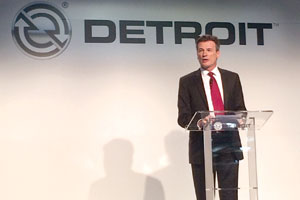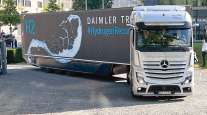Bernhard: Trucking to Benefit From Autonomous Car Push

REDFORD, Mich. — The path to the autonomous truck remains clear and is actually being made easier by the aggressive steps being pushed by the passenger car segment, the head of Daimler’s global commercial vehicles division said.
“There’s a number of months and years ahead of us making sure that the system works under every possible condition,” Wolfgang Bernhard said. “It is a federal issue in the United States — making sure these systems are allowed across states. We believe by the time federal laws are being implemented and regulation is ready, we will be ready with a truck.”
Bernhard stressed that Daimler Trucks’ focus remains not on creating a driverless truck but a system of autonomous assistance that allows a trucker to let go of the steering wheel and foot pedals under the right conditions.
The trucker is not always actively driving, but under the correct circumstances “leans back and observes what the truck is doing. We see this as the next logical step from adaptive cruise control,” Bernhard said.
He said tests show a 25% reduction in stress level for drivers who need to monitor the truck and road conditions, but not actively steer.
“It helps us to make the truck drivers’ job a bit more attractive,” Bernhard said of the more relaxed work environment that autonomous driving can offer.
Bernhard made the comments at a Nov. 20 press conference after Daimler’s announcement it had launched production of its Detroit-branded DT12 automated manual transmission in the United States. It was his first formal meeting with the North American trucking press since the high-profile rollout of the autonomous “Inspiration” truck at Nevada’s Hoover Dam in May.
Martin Daum, president of Daimler Trucks North America, said the autonomous technology program is offering a “windfall” of advances, such as adaptive cruise control and advanced braking.
Sitting alongside the Daimler executives was Roger Penske, who at age 78 downplayed the chances of seeing autonomous-driving trucks going between Detroit and New York in his lifetime. The chairman of Penske Truck Leasing Co. and Penske Logistics, however, was quick to express his belief the research in autonomous technologies offers significant safety and fuel economy benefits.
Additionally, Penske said autonomous technologies could offer trucking a way to demonstrate reduced stress levels for truckers and negotiate longer hours of service.
Bernhard immediately seized on Penske’s comments, saying hypothetically, that a trucker could perhaps extend his or her driving time by five or 10 extra minutes per autonomous-hour driven.
“From a dealer perspective and also a user, we applaud those types of technologies as they come into the market. I think they are going to be here from a safety standpoint. Also, if the driveability of the vehicle can be done automatically, we are going to get better fuel economy, which is going to help out costs,” he said.
Bernhard said technology giant Google as well as passenger car companies, including Daimler’s Mercedes-Benz unit, are hastening the reality of autonomous trucks.
Bernhard led the Mercedes’ car division before moving to Daimler’s commercial vehicles side in 2013.
Car companies are racing to build a completely autonomous vehicle able to navigate congested urban areas with red lights, bicyclists and pedestrians, Bernhard said.
That is different from Daimler’s vision for autonomous trucks, whereby the liability remains on the trucker to ensure safe operation of the vehicle as no additional infrastructure is required other than the truck being able to read existing road markings, he said.
No shortage of hurdles remains, Bernhard acknowledged, including legislative changes surrounding the steering wheel.
“International law has been changed — adaptation of local laws needs to take place so you can let go of the steering wheel,” Bernhard said.
“These laws, globally, are difficult to pass,” he said. “But it is not us at the front line . . . it is the passenger cars at the front line.
“They are trying to go much further with a fully automatic vehicle. They will get something done, I’m sure of that, because everybody sees the potential of it. We are just going to enjoy the fallout,” he added.
The truck maker recently demonstrated its Highway Pilot system — enabling completely autonomously driving at speeds of up to 53 mph — in a Mercedes Actros truck on a public roadway in Germany.
Bernhard said not holding onto the steering wheel can be “awkward” at first but becomes natural very quickly after realizing Highway Pilot keeps “the truck perfectly straight within the two lines the camera is seeing.”




